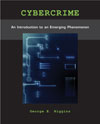 |  Cybercrime: An Introduction to an Emerging Phenomenon George E. Higgins,
University of Louisville
ContentsChapter 1. Introduction to Cybercrime
Chapter 2. Legal aspects of cybercrime
Fafinski, S. (2006). Access denied: Computer misuse in an era of technological change. Journal of Criminal Law, 424-442.
Chapter 3. Cyberharassment/Cyberstalking
Alexy, E. M., Burgess, A. W., Baker, T., & Smoyak, S. A. (2005). Perceptions of cyberstalking among college students. Brief Treatment and Crisis Intervention, 5, 279-289.
Barak, A. (2005). Sexual harassment on the Internet. Social Science Computer Review, 23, 77-92.
Finn, J. (2004). A survey of online harassment at a university campus. Journal of Interpersonal Violence, 19, 468-483.
Ybarra, M. L., & Mitchell, K. J. (2004). Online aggressor/targets, aggressors, and targets: A comparison of associated youth characteristics. Journal of Child Psychology and Psychiatry, 45, 1308-1316.
Chapter 4. Cyberpornography
Buzell, T. (2005). Demographic characteristics of persons using pornography in three technological contexts. Sexuality & Culture, 9, 28-48.
Peter, J, & Valkenburg, P. M. (2006). Adolescents’ exposure to sexually explicit material on the Internet. Communication Research, 33, 178-204.
Quayle, E., Vaughn, M., & Taylor, M. (2006). Sex offenders, Internet child abuse images and emotional avoidance: The Importance of values. Aggression and Violent Behavior, 11, 1-11.
Stack, S., Wasserman, I., & Kern, R. (2004). Adult social bonds and use of Internet pornography. Social Science Quarterly, 85, 75-88.
Williams, K. S. (2005). Facilitating safer choices: Use of warnings to dissuade viewing of pornography on the Internet. Child Abuse Review, 14, 415-226.
Chapter 5. Cyberfraud/Identity Theft
Burns, R. G., Whitworth, K. H., & Thompson, C. Y. (2004). Assessing law enforcement preparedness to address Internet fraud. Journal of Criminal Justice, 32, 477-493.
Marshall, A. M., & Tompsett, B. C. (2005). Identity theft in an online world. Computer Law and Society Report, 21, 128-137.
Sauders, K. M., & Zucker (1999). Counteracting identity fraud in the information age: the identity theft and assumption deterrence act. International Review of Law Computers, 13, 183-192.
Chapter 6. Intellectual Property Theft
Higgins, G. E., Fell, B. D., & Wilson, A. L. (2006). Digital piracy: Assessing the contributions of an integrated self-control theory and social learning theory. Criminal Justice Studies: A Critical Journal of Crime, Law, and Society 19, (1), 3-22.
Higgins, G. E. & *Makin, D. A. (Spring 2004). Does social learning theory condition the effects of low self-control on college students’ software piracy? Journal of Economic Crime Management (www.jecm.org), 2, (2), 1-22.
Hinduja, S. (2003). Trends and patterns among on-line software pirates. Ethics and Information Technology, 5, 49-61.
Piquero, N. L. (2005). Causes and Prevention of Intellectual Property Crime Trends in Organized Crime, 8(4): 40-61.
Chapter 7. Hackers, Crackers, and Phone Phreaks
Wark, M. (2004). Hackers. Theory, Culture, & Society, 23, 320-322.
Chapter 8. Criminal Justice and Cyberspace
Hinduja, S. (2004). Perceptions of local and state law enforcement concerning the role of computer crime investigative teams. Policing: An International Journal of Police Strategies & Management, 27, 341-357.
Nord, D., McCubbins, T. F., & Nord, J. H. (2006). E-monitoring in the workplace: Privacy, legislation, and surveillance software. Communications of the ACM, 49, 73-77.
Chapter 9. Cyberforensics
Berghel, H. (2003). The discipline of Internet Forensics. Communications of the ACM, 46, 15-20.
Loper, K. (2001). A case study in the forensics of computer crime: E-mail address spoofing. Journal of Security Administration, 24, 45-69.
Panda, B., Giordano, J., & Kalil, D. (2006). Next-generation cyber forensics. Communications of ACM, 49, 45-47.
Walden, I. (2005). Crime and security in cyberspace. Cambridge Review of International Affairs, 18, 51-68.
Chapter 10. Future Issues
Myers, L. J., & Myers, L. B. (2003). Identifying the required knowledge elements for the effective detection, investigation, and prosecution of high technology crime: The perspective of academe. Journal of Criminal Justice Education, 14, 245-267.
Hiduja, S. (2004). Theory and policy in online privacy. Knowledge, Technology, & Policy, 17, 38-58. |
|



 2010 McGraw-Hill Higher Education
2010 McGraw-Hill Higher Education

 2010 McGraw-Hill Higher Education
2010 McGraw-Hill Higher Education